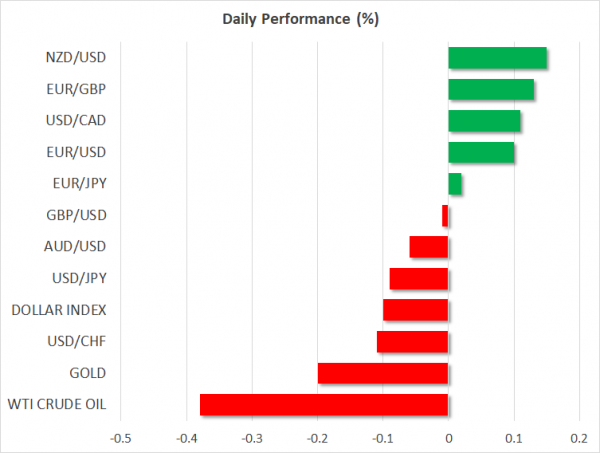- Safe-haven favourites, the dollar and the yen, trade near Friday’s lows as positive data out China triggers a risk rally
- Encouraging comments from Mnuchin on US-China trade talks also helps risk sentiment
- Focus this week to centre on US earnings and China GDP ahead of long Easter weekend
Jump in Chinese lending eases growth jitters
Fears of a global slowdown, which were amplified early last week after the IMF lowered its global growth forecasts, subsided substantially on better-than-expected economic indicators out of China on Friday. Chinese exports rebounded strongly in March, but more significantly, loan growth accelerated during the same month, in a sign that the government’s efforts to stimulate lending are starting to take effect.
The safe-haven yen fell across the board after the data as investors fled to riskier assets on hopes that the slowdown in the world’s second largest economy is bottoming out. The yen skidded to one-month lows versus the US dollar at 112.09 yen, while the risk-sensitive Australian dollar rallied to a near 4-month top of 80.48 yen. The US currency also came under pressure against most of its major peers, with the dollar index slipping to two-week lows.
In the bigger picture, however, many currency pairs remain confined to their recent ranges and investors will be looking for further validation that the global economy is at a turning point before paring back their long US dollar positions, which have now hit their highest since December 2015.
One big clue that the worst of the slowdown is over could come from China’s first quarter GDP growth estimates due on Wednesday. Any negative shocks from the GDP data could undo much of the improvement in risk appetite seen since late last week.
US-China trade talks could be in ‘final round’
Another cause of optimism were signs that talks between the US and China were nearing their end after US Treasury Secretary, Steven Mnuchin, told reported on Saturday that they were “getting close to the final round of concluding issues”.
But while markets cheered Mnuchin’s comments, traders maintained some level of caution as next in line for the Trump administration’s tough trade demands is Japan. Japanese officials will begin talks with their US counterpart in Washington today, opening the prospect of a new trade battle just as one is coming to an end.
Earnings season gets off to a positive start
In case trade frictions start to escalate again, not just with Japan but with the European Union too, a strong earnings season in the US looks set to support market sentiment over the next few weeks. Banking giant, JP Morgan reported stronger-than-expected earnings on Friday, sending its share price to close almost 5% higher. The upbeat results drove the main US indices higher, with the S&P 500 surpassing the 2900 level and approaching its all-time high from September 2018.
However, shares in Asia were unable to hold on to all of their earlier gains on Monday and European indices opened mixed, amid concerns about overvaluations and ongoing uncertainties such as Brexit.
Euro and pound make modest gains as regional gloom recedes slightly
As the UK Parliament goes into Easter recess, investors will be able to breath a sigh of relief from fewer Brexit headlines. However, any developments regarding the talks between the Conservatives and Labour to reach a consensus on a Brexit deal could still upset sterling, which is currently testing the $1.31 level once again. A barrage of UK data this week will also keep the pound under the spotlight, with jobs number out first on Tuesday.
The pound received a small boost last week after the EU extended the Brexit deadline to October. The euro was also bolstered after Eurozone industrial production numbers fell less than expected in February and M&A activity provided additional support, lifting the single currency above the $1.13 handle.
Commodities start week on negative footing
The risk-on mood failed to benefit commodities such as oil on Monday as Russia signalled it may not sign up to further cuts in output with OPEC and could even hike production. Russia is worried about losing market share to the US, which continues to enjoy rising production. Both WTI and Brent crude prices drifted away from last week’s 5-month highs on Monday.
Meanwhile, gold prices fell further below the $1,300 level as risk appetite continued to recover.















